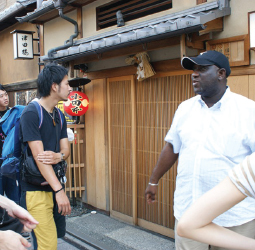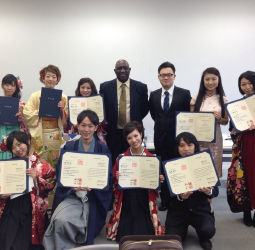Home > Highlighting JAPAN >Highlighting Japan December 2015>Home away from home
Highlighting JAPAN


Space Explorer
Hailing from the nation of Mali, Oussouby Sacko came to Japan to expand the range of his research following a study abroad program in China. His mission is to explore the intersection between culture and the spaces people create, as well as to bring his country and Japan closer together.
Prof. Oussouby Sacko is the dean of the faculty of humanities at Kyoto Seika University, where he studies the relationship between space and culture and how it is applied to public and private spaces in urban planning and architecture.
Sacko had no idea what to expect when he came to Asia from his native Mali some thirty years ago, a high school graduate heading to China in the mid-eighties on a Malian government scholarship to study architecture. He spent a year in Beijing and five years in Nanjing, and it was there, Sacko says, that he began to learn about not just the world outside of Mali but also about Mali itself.
“While I was in China, I got the opportunity to visit Japan,” Sacko recalls. “I was impressed not only by the development but the relationship between people and their spaces—the cultural attachment to their spaces.” The way that traditional spaces in Japan were integrated with modern spaces intrigued him. As an architectural student, he had learned “how to destroy existing things and replace them with new ones.” And in China, as in Mali, the focus was on development rather than planning or preservation.
“We were not thinking about the continuity between what exists now and what will exist in the future,” he says. “We were always thinking about replacement. So when I first got to Japan, there was a big difference.”
That difference drove him to move to Japan, where he entered the Graduate School of Engineering at Kyoto University in the Architecture and Architectural Engineering Department, and subsequently earned both a master’s degree and a PhD.
In 2001, Sacko joined the faculty of Humanities and the Graduate School of Design (Architecture) at Kyoto Seika University, where he continues to explore the idea of space and the way it is perceived in Japan, Mali and elsewhere. When asked what Japan and Mali can learn from each other in terms of space and culture, he says the two countries are simpatico when it comes to ideas of space, in contrast to some Western/European cultures, where spaces tend to serve a single purpose. In Japan, there is more flexibility: spaces are multifunctional, and they retain ties to traditional culture. “We can conserve some spaces,” he notes, rather than tearing down everything to start afresh. “We can integrate those spaces into modern design. Japan is modern, but at the same time there’s continuity.”
Sacko cites the Japanese home as a good example of the modern blending with the traditional in a multifunctional way. Even as houses and structures are made of new materials, many homes still have tatami mats and areas that can be used as an eating space, living space or sleeping space, swapping out low tables for cushions or futon mattresses depending on the time of day and utility desired.
But he believes Japan can learn from Mali as well. In a Malian house, for example, there is a courtyard, and “the space is very flexible,” Sacko states. “It’s a space to eat, talk and rest.” Families use the space to connect with each other, and family members—often several generations living together—see each other every day.
“In Africa we have those spaces in transition, but we still have those traditional spaces at the same time,” he says. “Which is like the place for family—something that is disappearing a little from Japanese society and urban areas.” He fears that family and community spaces are being lost in favor of more private, individual spaces.
Sacko has also worked hard to open channels of communication between Mali and Japan, creating a volunteer group to help international students integrate into the community, advising the Kyoto government on internationalism, working with the exchange student program at Kyoto Seika, and creating an international meeting space on campus. He also acts as facilitator for governments and research trips between Japan and various African countries. He believes there are a lot of opportunities on both sides to study and contribute to culture and society, and fervently hopes that young people in both countries will be up to the challenge.
He knows that venturing out into the world to create community and share knowledge can be daunting when at times society seems increasingly compartmentalized. “But in the end, we see that people really need each other.”
© 2009 Cabinet Office, Government of Japan








